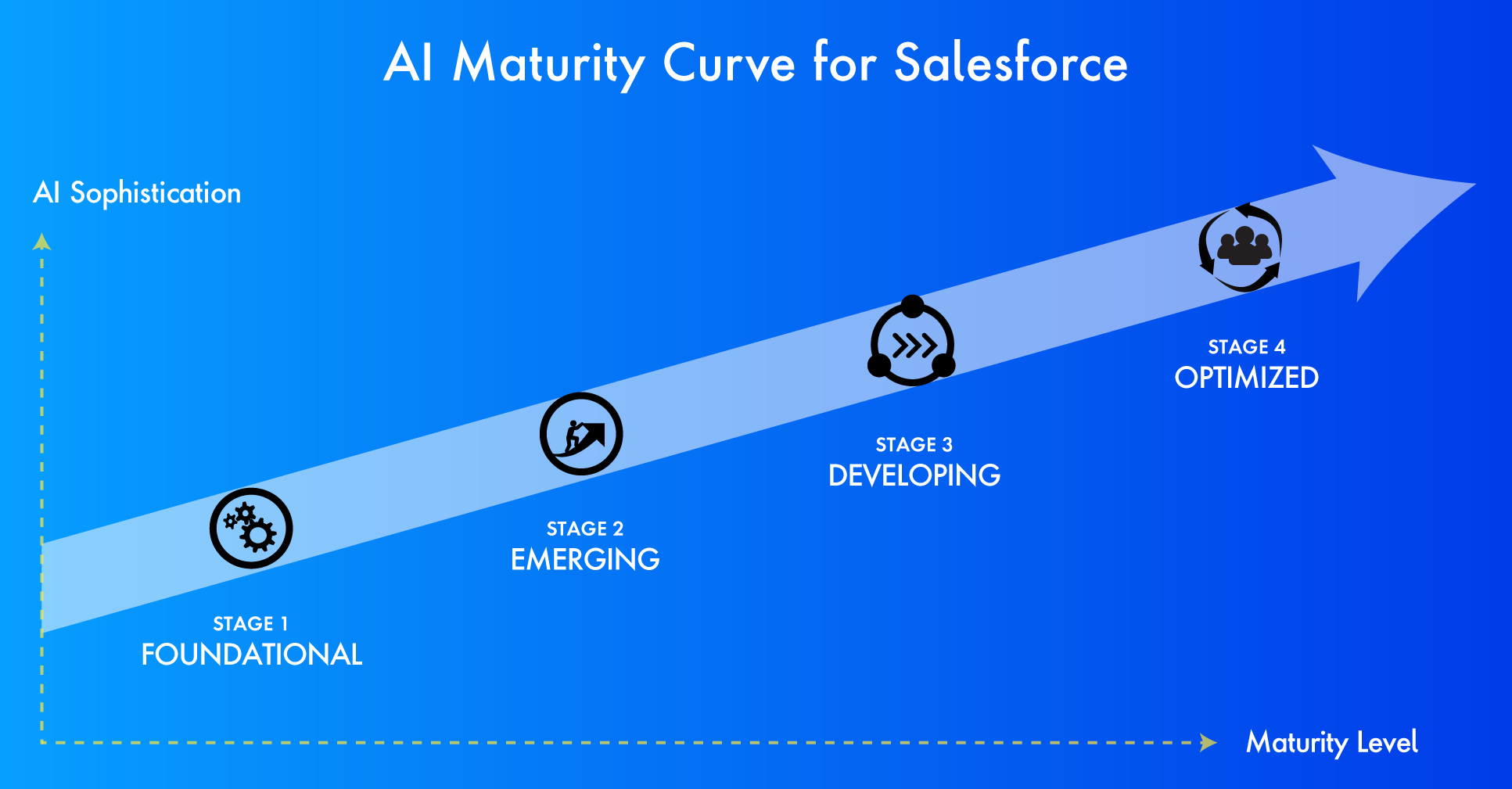What issue can we solve for you?
Type in your prompt above or try one of these suggestions
Suggested Prompt



Insight
Understanding Your Organization's AI Maturity in the Salesforce Ecosystem
Understanding Your Organization's AI Maturity in the Salesforce Ecosystem
The transformative power of AI lies not just in the technology itself but in its seamless integration into an organization’s strategy, its alignment with business objectives, and the ethical considerations guiding its deployment. Salesforce’s Einstein GPT, the Einstein Trust Layer, Einstein Studio, and other emerging capabilities offer a compelling reason for organizations to assess, identify and recognize their own AI maturity. More importantly, the recently announced Einstein Studio streamlines AI integration for businesses, combining a "bring your own model" (BYOM) solution and curated AI for efficiency.
Think of the process as more than a diagnostic tool — it is a beacon guiding your organization’s path ahead.
Identifying your AI Maturity
An organization's AI maturity reflects more than merely its technical prowess. Instead, it's an indicator of how effectively they've harnessed increased efficiencies in productivity, improved customer experiences, devised innovative business strategies, cultivated a rich pool of diverse and skilled resources, and championed ethical, use-case-driven AI solutions.

To move your business to this ideal end state of AI maturity, you’ll need to pass through four stages. The Foundational Stage represents the initial phase, where organizations begin their journey with a basic understanding of AI, its potential, and its implications. As they progress to the Emerging Stage, the power of AI is acknowledged more, and there's a budding effort to integrate it with strategic vision, emphasizing ethical AI practices. The journey continues into the Developing Stage, marked by advanced integration, the inclusion of Generative AI, and deeper alignment with and expansion across Salesforce Clouds. By the time organizations reach the Optimized Stage, AI becomes an integral part of their ecosystem, driving innovation and steering an AI-centric approach in decision-making and strategy.

Several pillars underpin the AI maturity curve in the Salesforce landscape. A clear AI strategy and vision tailored to Salesforce Einstein are paramount. This is complemented by rigorous data governance practices that ensure data quality, security and compliance within the Salesforce platforms. The importance of a solid data infrastructure cannot be overstated, as it ensures data for Salesforce Einstein GPT. The human element, represented by a robust talent pool specializing in Salesforce Clouds, brings continuous upskilling to the table. Ethical and responsible AI practices are non-negotiable, integrating ethical guidelines while ensuring AI's responsible use. As for the model development lifecycle, the focus is on standardizing and refining processes, with a keen eye on automation. Performance monitoring gains traction with an emphasis on refining Salesforce Einstein models through AI-driven insights. All these efforts culminate in business integration focused on achieving unified customer experiences across Salesforce Clouds. The journey is rounded off with an emphasis on user adoption, fostering a data-driven organizational culture, and continually pushing the boundaries of Salesforce Einstein.
To understand and recognize your AI maturity stage, think of the process as more than a diagnostic tool; it is a beacon guiding your organization’s path ahead. Each step forward helps you extract the maximum potential from Salesforce Einstein and create a holistic relationship between AI and organizational objectives.
Ready to Learn More?
Check out these other articles in our AI Series: Introducing the AI Scorecard! • Your Blueprint for AI Success • Publicis Sapient, Salesforce & AI • What Is Your AI Readiness?
Related Reading
-
![]()
Unlock Real-World Value through Practical AI and Salesforce
Publicis Sapient is partnering with Salesforce and Publicis Sapient AI Labs to help businesses unleash practical AI solutions to solve complex challenges.
-
![Silhouettes of people walk through a night cityscape creating a sense of speed, modernity, and constant motion.]()
The Future of Customer Engagement: Inside Salesforce's AI Ecosystem
Salesforce's innovative vision for data and AI enables revolutionary customer engagement experiences.
-
![]()







